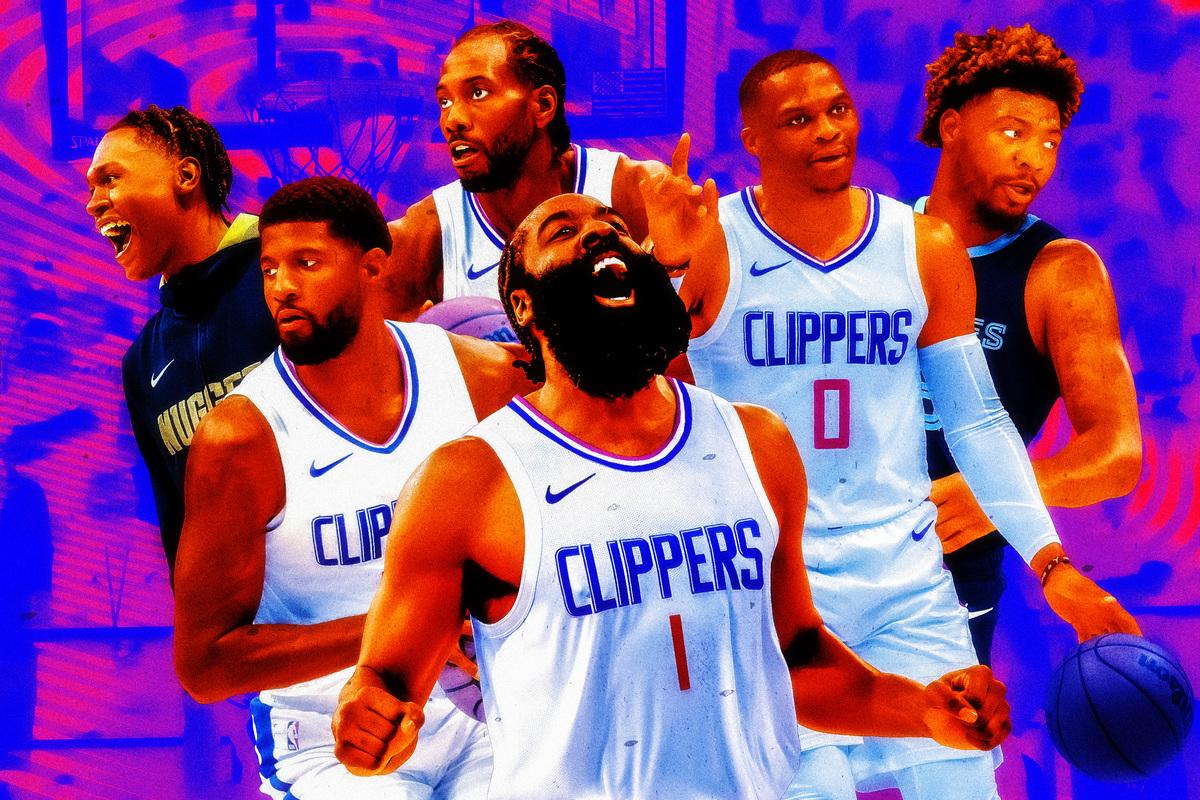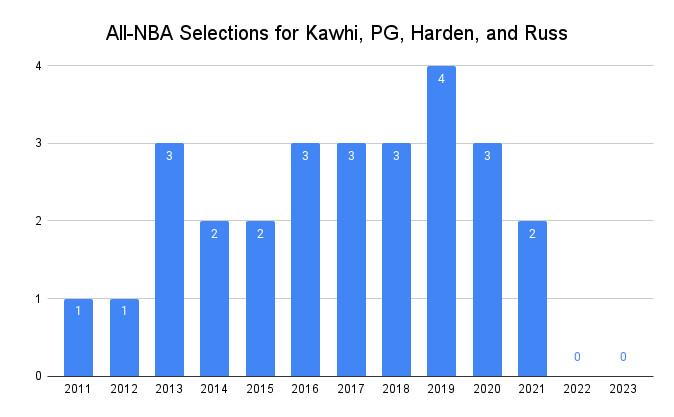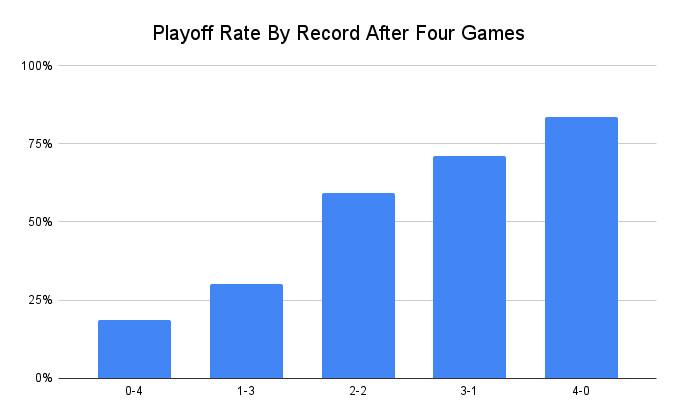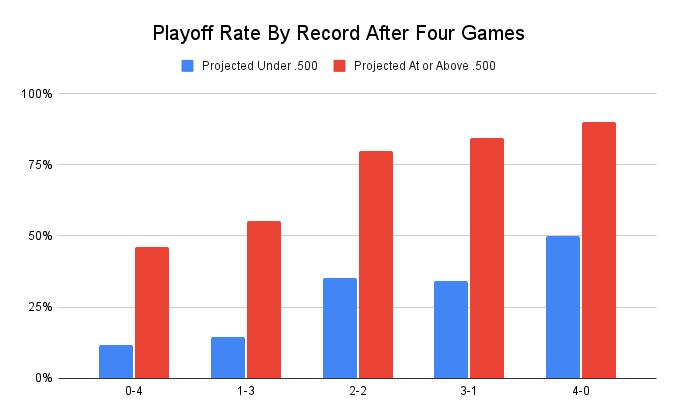
Each Wednesday of the NBA season, we’re analyzing a grab bag of topics from around the league—from the essential stories to the wacky moments, from statistical analysis to obscure minutiae. This week: the viability of the Clippers’ old, new Big Four, five young players who are potentially making the leap, the Grizzlies’ winless start, and more. This is the Kram Session.
Under Review: The Old Men and LAC
The oldest team in the NBA just got older. That’s one of the many ripples of the latest James Harden trade, which (finally) sent the former MVP and P.J. Tucker to the Clippers in exchange for a collection of players, picks, and swaps. Ringer teammates Seerat Sohi and Michael Pina have you covered from the perspectives of Harden and the 76ers, respectively, so I’ll tackle a few Clippers-centric dimensions here.
At least in theory, the Clippers stars generally mesh, albeit more in timeline than on the hardwood. If Kawhi Leonard and Paul George miss games in the regular season, Harden and Russell Westbrook can help keep the Clippers afloat and firmly in the playoff field, as opposed to dropping to the play-in portion of the standings. And if Harden succumbs to his traditional playoff malaise, Leonard—a Finals MVP and one of the great playoff performers in NBA history—can pick up the slack.
Since the Clippers have so many high-scoring ball handlers on the roster, each star will need to sacrifice to make the pieces fit. Incidentally, Westbrook was already showing signs of such adaptation before the Harden trade. His usage rate is only 16.9 percent, as of Tuesday afternoon, a decline of 10.8 percentage points compared to 2022-23. That’s the largest drop for any player through the first week (minimum 50 minutes) and an eye-popping number for Westbrook, who’d never dipped below 25.7 percent in any season of his career until now.
For years, Westbrook faced criticism for not adapting his style to match his declining skill set and place in his team’s pecking order. But he’s finally playing that way—as a distributor first and scorer second—for the Clippers.
Numerous questions about this group of stars will remain open until they start playing together. Can Westbrook adapt even more if he has to come off the bench? Is Harden willing to drop his usage rate too, after it’s already fallen four seasons in a row? And will Leonard and George adjust to make room for a new facilitator? These are the questions the Clippers must confront after assembling a team of late-career stars with well-established styles.
That “late-career” aspect is important, too. Through three games, the Clippers’ average pre-trade roster age—weighted by minutes played—was 30.6 years, the highest in the NBA. The only other team in the past decade with an age that high was the 2017-18 Cavaliers (also 30.6), who went 50-32 before losing in a Finals sweep.
Once the Clippers incorporate their new players into the rotation, their figure will probably inch upward, but not by a tremendous amount. While KJ Martin is only 22 years old, the other players headed to Philadelphia in this trade are veterans: 34-year-old Nicolas Batum, 34-year-old Marcus Morris, and 32-year-old Robert Covington. And 27-year-old Terance Mann hasn’t played yet this season because of an ankle injury, but he’ll return soon to add younger minutes to the Clippers ledger. On the other hand, Harden is 34 years old, and Tucker is 38; these Clippers will certainly remain the oldest team in the current NBA.
Yet is a team full of 30-somethings too washed up to win in an NBA that’s skewing younger? League history suggests that it isn’t. Older teams tend to win a lot of games. As I wrote a couple of years ago, the 18 oldest teams in NBA history, and 28 of the top 29, finished with a .500 record or better. And there are plenty of examples of over-30 teams that have won the championship:
- 1997-98 Bulls (31.7—third-oldest team ever)
- 2010-11 Mavericks (30.9)
- 1996-97 Bulls (30.7)
- 1968-69 Celtics (30.5)
- 2006-07 Spurs (30.4)
- 2012-13 Heat (30.3)
- 1998-99 Spurs (30.1)
Just this season, in fact, the Clippers are far from the only old team angling for a title. The five oldest teams in 2023-24 are the Clippers, Bucks, Warriors, Suns, and Lakers—all of whom rank as top-tier title contenders. (The Bulls are also tied for fifth in average age with the Lakers, but they’re decidedly not top-tier title contenders.)
Other title contenders include the 76ers (seventh oldest), Celtics (eighth oldest), and Heat (ninth oldest). The Nuggets, who sit 14th in average age, at 26.6 years, with all five of their returning starters still 30 or younger, are thus an outlier among the NBA’s elite. That deviation helps illustrate why this Nuggets core might remain among the championship favorites for years to come. But for now, Harden’s Clippers are merely the most extreme example of a leaguewide phenomenon of old teams intent on taking down the prime-age champs.
Zacht of the Week: 27 All-NBA Appearances
Let’s stick with Harden’s new team for one more section because the Clippers really have assembled one of the greatest sets of pure talent in NBA history. Their four stars have combined for 27 All-NBA appearances in their careers thus far, the most for any current roster.
Career All-NBA Appearances by Current Team
When healthy, Westbrook, Harden, George, and Leonard were All-NBA mainstays for a full decade. From Westbrook’s breakout in 2010-11 through 2020-21, at least one member of this quartet was an All-NBA selection every year. From 2012-13 through 2020-21, at least two were.

But look at the far-right end of that graph: In the past two seasons, nobody from this foursome has returned to an All-NBA squad, or even come close. That’s a far cry from 2018-19, when all four players made an All-NBA team, or from 2016-17, when Westbrook, Harden, and Leonard were the top three finishers in a contentious MVP vote.
Granted, some of that absence is the result of a degradation in health more than ability. Leonard in particular remains a top-15 player when available, and George is off to a scorching start. But given the injury histories of the Clippers’ stars, those health concerns have to be baked into their championship chances. In a vacuum, perhaps, a roster of the Clippers’ age should still win a lot of games and compete for the championship. But in the specific case of these Clippers, the team’s key players might be too far removed from their primes to make that kind of run.
One Small Step for Man, One Giant Leap for These Five Players
The first week of the NBA season is a bit like the first days back at school after summer break. We get to see our friends again, catch up on gossip, and observe who’s changed the most, whether it’s by getting taller or removing their braces or sporting a tan from a trip to the beach.
Let’s zoom in on that latter group to name a “One-Week-In All-Leap” team. Note that players who were already on a clear path to stardom, like Eastern Conference Player of the Week Tyrese Maxey, aren’t included here; it was already apparent that he was poised to break out, especially if he assumed full point guard duties without Harden there to dominate the ball.
Rather, we’ll take a trip around the league to analyze five players who have returned from the offseason and taken a big leap earlier than expected.
Guard: Peyton Watson, Denver Nuggets
Trying to find a potential Nuggets weakness entering this season was essentially a process of elimination. The issue isn’t the starting lineup: All five of the reigning champion’s starters are still on the team, fairly young, and healthy (kinehora). It’s not the coach or the front office or that last season was somehow a fluke.
So what’s left? The bench. Here, there were some signs of wear and tear, as the Nuggets lost Bruce Brown and Jeff Green in free agency, leaving only five and a half rotation players from their 2022-23 title effort. Brown’s departure in particular could represent a massive blow, given his two-way impact and fit with Denver’s stars.
But so far, so good for the Nuggets’ replacement reserves. Christian Braun—the aforementioned half-rotation player from the playoffs—has been solid in his sophomore season, and Reggie Jackson has enjoyed a hot start as the backup point guard. Yet the real revelation of the Nuggets’ first week is Watson, the no. 30 pick in the 2022 draft who barely played as a rookie.
Nuggets general manager Calvin Booth expected a leap from Watson this season. He told our Kevin O’Connor, comparing Watson to Brown, “Peyton’s bigger. He’s longer. He’s more athletic. He guards better. He passes better. He doesn’t have the experience, and he’s not as good offensively yet, but we need defense more than we need offense on our team.”
Watson has provided all of those attributes and more through four games, and he’s already earned Mike Malone’s trust—no small feat given that the coach has historically preferred veterans to youngsters. Watson has six blocks in four games, and on the offensive end, he’s picked his spots, cut hard, and stayed within the flow of Denver’s offense. Out of his 22 shot attempts, 19 have come either at the rim or beyond the 3-point line; 13 of his 14 makes have been assisted. The Nuggets have even outscored their opponents with Nikola Jokic off the floor.
Guard: Cam Thomas, Brooklyn Nets
Here’s the full list of NBA players who started a season with three consecutive 30-point games at age 22 or younger:
- Cam Thomas
- Giannis Antetokounmpo
- Shaquille O’Neal
- Marques Johnson
- Rick Barry
- Oscar Robertson
That’s decent company for the third-year Nets guard. And it’s not just that Thomas, who also had a weeklong points binge midway through last season, is scoring in bunches; it’s that he’s doing so in a sustainable way by drawing lots and lots of free throws.
Through three games, Thomas has averaged 10 free throw attempts, which is tied for the league lead with Giannis. Every other player in the top 15—Trae, Bam, Dame, Luka, Durant, Embiid, DeRozan, Maxey, Butler, Fox, LaVine, Curry, and Davis—is a star.
Forward: Jalen Johnson, Atlanta Hawks
Johnson is a former first-round pick—no. 20 in 2021—but his production never matched his pedigree until this season. On the 2022-23 Hawks, he ranked a distant ninth in playoff minutes and points.
But Johnson has built on a strong preseason with an even stronger start to the regular season; he’s had a collection of highlight-reel dunks, efficient offense (75 percent on 2s, 40 percent on 3s), and at least one block and one steal in every game. After starting the season on the bench, Johnson has already forced his way into Quin Snyder’s starting lineup. He’s more than replaced John Collins as a big wing athlete who can run with Trae Young.
Forward: Ausar Thompson, Detroit Pistons
Most rookies take time to adjust to the NBA level, especially on defense. Advanced stats show that only a few rookies, at best, make a positive impact on that end of the floor each year. But the eye test shows that Thompson already belongs in that rarefied air. (Two fellow rookies, Chet Holmgren and Victor Wembanyama, profile as even more valuable game-changing defenders because of their size.)
For a player whose highest level of competition before this season was the Overtime Elite league, Thompson has adapted remarkably quickly to guarding NBA players. And he’s not just putting the clamps on any old opponents—he’s harassing stars like Shai Gilgeous-Alexander and Zach LaVine in isolation, cutting off their attack angles and forcing turnovers and tough shots.
Thompson also rebounds well (10.5 per game, including 4.3 offensive) and has a penchant for big blocks. Opponents are shooting just 29 percent near the basket with Thompson as the closest defender, albeit in a small sample. He can’t shoot and has a ways to go on the offensive end, but he’s years ahead on defense.
Center: Jalen Duren, Detroit Pistons
Things are looking up, Pistons fans—that’s two leapers in a row! And what a leaper Duren is, literally. The 6-foot-10 center leads the league with 18 dunks, five more than anybody else; ranks second with 5.3 offensive rebounds per game; and is shooting 68 percent on a steady diet of shots at the rim.
Duren is still a teenager, meaning the 2022 draftee is younger than many of the players selected in 2023, and he profiles as a pick-and-roll monster, given his vertical spacing and budding ability to make smart reads out of the short roll. It’s still early, but Duren has tripled his assist average from last season. Add in strong interior defense without fouling, and the Pistons have found their mobile big man of the future.
Take That for Data: A Grisly Start in Memphis
Without Ja Morant, without Brandon Clarke or Steven Adams, without even Santi Aldama and Luke Kennard, the Grizzlies have the worst record in the NBA. This is the only team in the West that won 50-plus games in each of the past two seasons, yet it’s now 0-4 with a floundering offense. Memphis even lost to the Wizards. Is this Grizzlies season already doomed?
To look for precedents that might inform Memphis’s new outlook, I first looked at all teams in the 21st century, splitting them by record through their first four games and then whether or not they qualified for the postseason. Unsurprisingly, teams with better starts had better outcomes, and those with 0-4 starts went on to make the playoffs just 19 percent of the time.

But there’s one issue with that graph: Good teams are obviously more likely to start the season with good records, and bad teams with bad records. So to go one step further, I split those results by the expectation every team had entering the season, which allows a more nuanced pattern to emerge.
Here, we see much more hope for Memphis, which entered the season with a Vegas win projection in the mid-40s. Out of 13 previous teams this century that had a .500-or-better projection but started 0-4, six (or 46 percent) rebounded to make the playoffs. That’s still not ideal for Memphis fans who want another playoff trip—but precedent holds that the Grizzlies are in much better shape than teams with sub-.500 projections who start the year with a hot streak.

In other words: Don’t change your opinion too much about a team because of its start, in either direction. I found a couple of years ago that teams’ preseason Vegas projections remain better predictors of their rest-of-season record until about the 25-game mark, at which point their current record starts to more accurately predict their future.
Moreover, in Memphis’s case specifically, this analysis doesn’t account for the Grizzlies’ unique circumstances—they’ll surely improve after the 25-game mark, when Morant returns from his suspension—or the extra opportunity provided by the play-in rounds. But history suggests that teams in Memphis’s position have something like a coin-flip chance to make the playoffs. In a loaded Western Conference, that seems about right.
Fast Breaks
1. The Raptors are bringing basketball back to the Jurassic Age.
I had a friend in college who couldn’t get interested in the NBA. The problem, she explained, was that basketball was too high-scoring, which made every point feel mundane. In her favorite sport, soccer, every goal was a real achievement worth celebrating.
Maybe she’d begin to like the NBA if she tuned in to Raptors games. There have been only four games this season in which both teams had scored under 100 points by the end of regulation—and the Raptors have played in three of them.
If a team were trying to produce the lowest-scoring games in the NBA, it could scarcely do a better job than Toronto. The Raptors check off every box: They’re 30th in offensive rating, third in defensive rating, and 30th in pace.
And check out the 1-3 Raptors’ upcoming schedule: Bucks, 76ers, Spurs, Mavericks, Celtics, Wizards, Bucks again, and Celtics again. The Pascal Siakam and O.G. Anunoby trade rumors will grow louder and louder with every loss in that span.
2. No fines is just fine.
The NBA fined Joel Embiid $35,000 for his crotch-chop celebration after making a layup on Sunday. But two players who weren’t fined for possible first-week infractions were Luka Doncic and LeBron James, who both swore on a live mic on national TV during postgame interviews.
Both players slipped up in praise of a teammate. Luka said that rookie Dereck Lively II “played fucking amazing” in his first NBA game, while LeBron noted twice that the Lakers “don’t give a shit” about criticism of Anthony Davis.
NBA players, including stars, have been fined for cursing in postgame interviews before, and the league has made it a point to crack down on public profanity. Signs posted in NBA locker rooms remind players that, among other things, “profane or objectionable language should be avoided in public (like when talking to the media or posting on social media).”
But LeBron and Luka escaped penalty this time—the latter even though, as a Howard Beck piece from 2022 noted, “any version of fuck … is almost an automatic penalty.” In this case, though, with Luka dropping an f-bomb after his first game of the season and immediately apologizing, the NBA didn’t issue a punishment. A league spokesman confirmed that the matter had been addressed internally, rather than with a fine.
To which I say: Good! If NBA players can actually express their emotions after an intense game—theoretically, the whole point of on-court postgame interviews—but a swear sneaks out here and there, that seems a worthy trade-off.
3. DominAyton isn’t dominating.
Deandre Ayton never had the typical offensive runway of a no. 1 pick. Playing next to Devin Booker—and then Chris Paul and Kevin Durant—Ayton never led his team in shot attempts or posted higher than a 24 percent usage rate.
But that was to some extent understandable, even if it led to discontent on Ayton’s part, because Booker, Paul, and Durant are All-NBA offensive talents. The same logic applies to Westbrook losing shots with the Clippers, or Jrue Holiday—with a 9.7-percentage-point drop in usage rate—with the Celtics this season. The same can’t be said for Ayton’s new teammates in Portland, and the Trail Blazers’ new center might have expected more shots playing for a rebuilding team without any undeniable stars to get in his way.
Yet through four games, Ayton ranks ninth in usage on the Blazers, behind the likes of Jabari Walker, Skylar Mays, and Toumani Camara. His 14 percent usage rate represents a drop of 8.9 percentage points compared to last season, which is the fifth-largest drop in the league (minimum 50 minutes).
4. RIP, All-Star draft
Within the past week, the NBA announced that the All-Star Game will return to its original East-vs.-West format, instead of keeping the mixed-league, player-draft approach it had used for the past six editions. The “Elam ending,” with a target score in the fourth quarter instead of a clock, will also be retired.
I suspect it will be difficult for any All-Star format to produce the level of competitiveness that commissioner Adam Silver desires, unless the exhibition is close in the final minutes. And I won’t mourn the loss of the player draft—except to remember the one moment when it shone truly bright.
The All-Star draft may be dead, but the 2022 edition’s high jinks, in which Kevin Durant refused to draft Harden after the latter had forced a trade from the Nets, much to the delight of LeBron James and the NBA on TNT crew, will live on forever.
5. If it ain’t broke, don’t fix it.
One small NBA delight that never fails to entertain me: When a team runs the same successful play over and over again, never deviating, daring the defense to finally get a stop. As famed NBA strategist Isaac Newton once said, an object in motion stays in motion unless acted upon by an outside force. There’s no reason to change the play call if the defense can’t stop the initial action!
We saw numerous examples of this law of coaching mechanics in the season’s first week. The Nuggets ran variations of the same play repeatedly down the stretch to beat the Lakers on opening night. A couple of nights later, the Lakers returned the favor against the Suns. The Bucks won their opener by spamming one action to free space for Damian Lillard. And the Bulls eked out a close game in Indiana by leaning on a set designed to attack Tyrese Haliburton.


